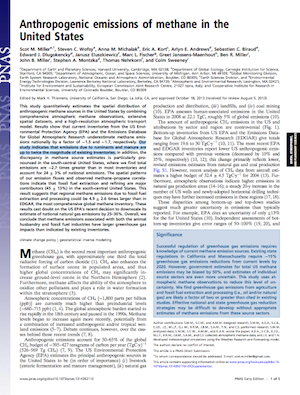New Study Suggests Much Larger Methane Emissions from Oklahoma and Neighbors
-
Joe Wertz

U.S. Department of Energy
A scientist at the Southern Great Plains research facility in Lamont, Okla., transfers air samples to a flask for transport back to a lab.
A new study of atmospheric methane in the United States suggests much higher levels than previously thought. The new data raises questions about the impact of natural gas production in Oklahoma and neighboring states, where emission estimates have more than doubled.

Proceedings of the National Academy of Sciences
Click here to read about the paper, "Anthropogenic Emissions of Methane in the United States"
Each year, the U.S. Environmental Protection Agency issues a report that tracks the country’s greenhouse gas emissions. In the 2013 update released in April, the EPA dramatically lowered its estimate of methane from natural gas production. Methane emissions looked like they were going down, while natural gas production from hydraulic fracturing was booming, news the energy industry eagerly embraced.
But new research casts doubt on the EPA’s declining methane numbers.
A study co-authored by more than a dozen scientists and published last week in the Proceedings of the National Academy of Sciences, shows the opposite: Nationally, methane emissions have increased by more than 50 percent. And in Oklahoma, Kansas and Texas, methane emissions are more than twice as high. That means a quarter of all of the country’s methane could be coming from just three states.
The study suggests two methane sources that were likely underestimated by the EPA and its international counterpart, the Emissions Database for Global Atmospheric Research: Livestock and the fossil fuel industry.

Joe Wertz / StateImpact Oklahoma
A bull ambles through the Wichita Mountains Wildlife Refuge in western Oklahoma.
Source of the Leaks
Cows and other cud-chewing, multi-stomached ruminants are major methane producers. “Our study indicates that emissions due to ruminants and manure are up to twice the magnitude of existing inventories,” the authors wrote in the paper.
“Cows are an important piece of this puzzle,” the study’s lead author, Harvard University Ph.D. student Scot Miller, tells StateImpact.
But while livestock is likely responsible for much of the country’s gas problem, Miller says the data suggests that methane emissions in Oklahoma, Kansas and Texas are likely related to the extraction and production of natural gas — which is mostly methane — a process that includes wells, pipelines and other equipment that can leak.
Estimate Differences
How does Miller know? And why are his numbers at odds with those generated by the EPA and EDGAR?
Part of the difference is in how the greenhouse gas inventories are calculated. Miller describes the EPA’s methodology as a “bottom-up” approach that estimates the total number of cows, landfills, wastewater treatment plants, oil and gas facilities, and other methane producers, and multiplies it by the amount of gas each might typically produce.
It’s “basically an accounting measure,” Miller says.
But for Miller’s study, the research team used an actual count of methane molecules detected in the atmosphere. The data came from the Department of Energy and National Oceanic and Atmospheric Administration, which took air samples during thousands of aircraft flights and from sensors placed atop towers that can be as tall as the Empire State Building.
And in the air above Oklahoma and its neighboring states, the sensors also picked up propane.
“Propane is a byproduct of the fossil fuel industries, but it’s not produced by cows, it’s not produced by wetlands, it’s not produced by most other methane sources.”
The methane sample data is from 2007 and 2008, which is the most recent available. But Oklahoma’s high methane emissions correspond with gushing natural gas production, at a time when the state had more rigs drilling for gas since the 1980s oil boom.
“That type of information really suggests to us that the oil and gas industry are key players,” Miller says.
The state agency charged with monitoring and regulating air emissions, Oklahoma’s Department of Environmental Quality, denied StateImpact an interview about how the new methane data might affect state pollution policy. The EPA declined an interview, too, and sent a boilerplate statement saying it welcomed any new data on greenhouse gas emissions. Miller, the study author, says that going forward, collaboration is the only way accurately assess the impact of greenhouse gasses.
“Both among people who do the type of top-down estimate that I do, and also people like those at EPA who construct the bottom-up inventories.”
Miller says another study using more recent methane samples is already underway.

